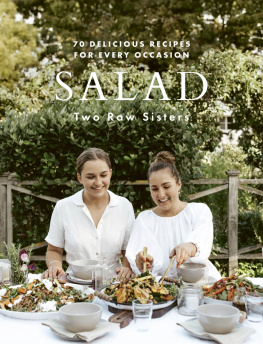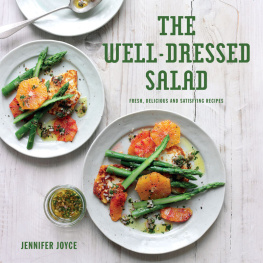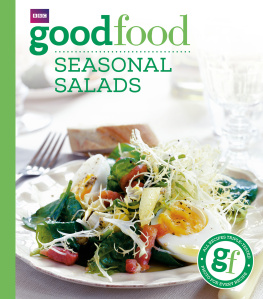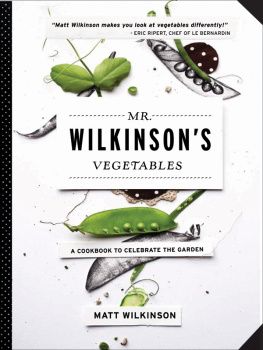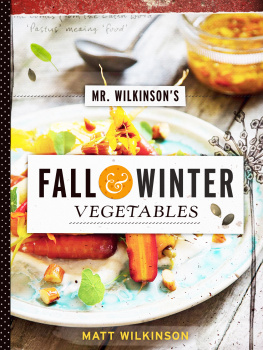CONTENTS
THANK YOU
Before you read on, I would like to say thank you for picking my book up. In a time when there are so many cookbooks out there, its amazing that you have taken the time to read, buy or just even flick through this one.
I hope you enjoy my thoughts on all things salads, and a love of food I share with my family.
The most joyous part of dining is not the food itself food is what we need to survive but the table and the SHARING of the food.
So where do we start? Simple, really. Lets look at this books title: Mr Wilkinsons Simply Dressed Salads. Its all in the name, they say. I cant tell you how many different thoughts have gone through my head in order to get to this title, but as time passed it was the first title that sat well with me.
My first book, Mr Wilkinsons Favourite Vegetables, was like most things in life about timing. It was my reflection, through recipes, of growing up, being in a kitchen and around food, and my philosophy (if we can use that word) about eating local and in-season food, from a belief that these are the most flavourful and tastiest. It really is so simple: buy the best tasty raw ingredients and foods from good producers, and the cook is already winning then cook it properly and hey, you have delicious food! The same philosophy goes for this book seasonal produce cooked well but this time its me looking at what I eat the most: salads!
So, why salads? Let me digress. I think of most food groups as a salad. Really I do. Why?
Well, the salad is one of the most diverse food groups ever, in some way or form. A burger is a burger, and a curry is a curry but salads are so wonderfully variable and can be hot or cold. Any ingredient can be made into a salad any vegetable, fruit, grain, pulse, seafood or meat not just salad leaves. A salad to me is simply a marriage of flavours and textures that you bring together; dress it with the right vinaigrette or dressing, and there you have it. For me, a salad primarily is designed to share, but on occasion can be brilliant on its own for breakfast, lunch or dinner, or any of the meals in between.
Which leads me to the question, do we all really think salads are just leaves or lettuce with other bits added? My little Hooligan number 1, Finn Thomas, after asking him how he enjoyed the little pumpkin salad I made for our family dinner, replied, No Dad, salads for caterpillars! This resonates so strongly with me that we all think salads are simply just salad leaves. Which really is crazy! The category for salad leaves is just that: a category. I dont know any salad leaf called salad leaf. Rocket (arugula), witlof, mizuna, yes but not salad leaf. Its not rocket science, its rocket leaves.
MY SALAD DAYS, AND A REVELATION
For those of you who dont know, I grew up in Barnsley, South Yorkshire, in that country called England. My father lived in a pub for some time, where my hospitality and culinary career really started. I worked for Rob Jane (my fathers best mate Alans son); he was my start-of-life mentor, who taught me to think for myself, work hard and have fun while doing it.
The Crown & Cushion was the pub I grew up in, and was my first look at adult life and what work was. The food on offer was very similar to most other pub food the plate generally consisted of a form of meat or fish taking pride of place on the whole plate, some form of potato (generally hot chips, we all love them) to cover the rest of the plate, and then you got asked by the wait staff, Vegies or salad? These really just being a plate filler.
It was this salad that offered my first insight as to what a salad was. We must have all seen it: iceberg lettuce cup filled with slices of onion, cucumber, tomato, radish, grated carrot and some baby mustard cress on top, served with a side of salad cream. It was the staple salad for the masses in pubs, clubs and I guess any food place that served a main meal. This was my first thought of a salad boring but refreshing, something healthy on the side of the meat and chips. When clearing tables in the pub, it fascinated me just how many people would leave the salad. Not eating that rabbit food crap! they would say. Back then, I wouldve had to agree.
My first insight into the workings of a professional kitchen was in Kingston upon Thames, on the outskirts of London, in a place called Warren House, under the guidance of mentor, friend and head chef Michael Taylor. It was here at Warren House, in my first job as a chef at seventeen, that I really saw what a salad could be. There were dishes named Waldorf, Nioise, Caesar, Caprese, Panzanella and Cobb, all foreign to me back then; saying that, you couldnt get the old potato salad or coleslaw past me. In those two years of my life I learnt so much about cooking and being a chef, but the lunch salad section was my first real insight into a proper salad, how to make a dressing and the many different types, how to get the right ratio of dressing to the leaves or produce used, learning flavour combinations and textures that make for a better salad, and getting them all out on time.
However, it wasnt until I was the head chef of Circa in Melbourne that I realised how good a salad could be, and how often I was making them and putting them on the menu, and not just as a side. Salad of this, or blah blah salad and so on until I stopped to think how deeply entwined the salad is within all cuisines and cultures. It makes sense to me to make and eat a lot of salads, so if you have to define me as a chef, I guess Im really good at doing seasonal salads, leaning on the vegetable side.
I really do think the concept of salad is changing in everybodys mind to be something other than just a leaf salad, and hopefully the recipes that follow will help you think about salads a little differently too.
ABOUT THIS BOOK
I have divided the salads into four seasons, with a little introduction to each chapter as to what grows in each season and how I feel at that particular time of the year.
There are thirteen recipes per chapter, as a guide to what to make during that season. Ideally I would love it if you made one salad a week, but see how you go. Please note that produce also often flows into the following season. Take tomatoes and basil, for example. These are a highlight of summer, but I was still picking stunning tomatoes in mid autumn, and I made my last batch of pesto for the Mrs and Hooligans in late autumn.
At the end of each season is a dressings family tree. Why? Well it annoys me that in many a cookbook there are some great recipes that can be used in so many other ways, but they dont tell you about it! I love Stephanie Alexanders Cooks Companion for this how she notes what a certain item also goes well with so I have included here, without recipes, a few other little things I would do with the dressings.
At the end of each season there is also a recipe for a fruit salad simple fruits of the season that make for a delightful change to just a plain old fruit number. I love cordials, so I have also shared with you some different ones I make throughout the year, so you can capture the bounty of each season to enjoy at a later time.
A COUPLE OF TIPS TO FINISH
Sometimes it can feel like were all starting to take cooking a little too seriously, making it a lot harder work than it should be. Whenever this happens I close my eyes and think of my Nanna Rita pottering around the kitchen, not a stress in the world. If you do stress in the kitchen, or at times dont enjoy the labourers chore of cooking, try the following tips for size; its what we do at home








